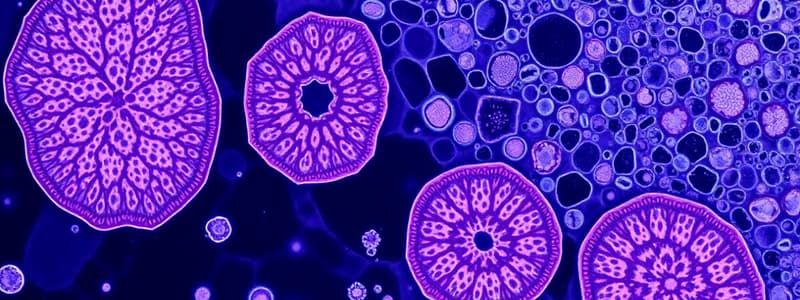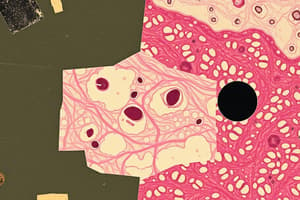Podcast
Questions and Answers
What is the primary function of simple squamous epithelium?
What is the primary function of simple squamous epithelium?
- Stretching to accommodate fluid volume
- Facilitates diffusion and filtration (correct)
- Protection against abrasion
- Secretion of mucus and enzymes
Where in the body would you find simple columnar epithelium?
Where in the body would you find simple columnar epithelium?
- Lining of lungs and blood vessels
- Skin and esophagus
- Lining of bladder and ureters
- Lining of stomach and intestines (correct)
Which type of epithelium is best suited for areas subject to abrasion?
Which type of epithelium is best suited for areas subject to abrasion?
- Stratified Squamous (correct)
- Simple Cuboidal
- Pseudostratified Columnar
- Transitional
What is the primary role of transitional epithelium?
What is the primary role of transitional epithelium?
Which epithelial tissue type involves secretion and movement of mucus?
Which epithelial tissue type involves secretion and movement of mucus?
What is the primary function of areolar connective tissue?
What is the primary function of areolar connective tissue?
Where is dense regular connective tissue primarily found?
Where is dense regular connective tissue primarily found?
Which type of connective tissue is responsible for cushioning and insulation?
Which type of connective tissue is responsible for cushioning and insulation?
What characteristic distinguishes fibrocartilage from other types of cartilage?
What characteristic distinguishes fibrocartilage from other types of cartilage?
What role does elastin play in connective tissues?
What role does elastin play in connective tissues?
Which connective tissue type is characterized by its ability to resist tension from multiple directions?
Which connective tissue type is characterized by its ability to resist tension from multiple directions?
What is the primary function of blood as a connective tissue?
What is the primary function of blood as a connective tissue?
What characteristic defines loose connective tissue?
What characteristic defines loose connective tissue?
What is the primary reason that bone heals faster than cartilage?
What is the primary reason that bone heals faster than cartilage?
Which type of muscle tissue is responsible for pumping blood?
Which type of muscle tissue is responsible for pumping blood?
Why are epithelial tissues more prone to cancer?
Why are epithelial tissues more prone to cancer?
Which layer of the epidermis is only found in thick skin?
Which layer of the epidermis is only found in thick skin?
What role do neurons primarily serve in the nervous system?
What role do neurons primarily serve in the nervous system?
What major problem can result from a deficiency in vitamin D?
What major problem can result from a deficiency in vitamin D?
Which of the following statements about the dermis is true?
Which of the following statements about the dermis is true?
Which major exocrine glands in the skin are responsible for producing sweat?
Which major exocrine glands in the skin are responsible for producing sweat?
What is one primary function of sebum secreted by sebaceous glands?
What is one primary function of sebum secreted by sebaceous glands?
Which type of gland is primarily responsible for body odor?
Which type of gland is primarily responsible for body odor?
Which skin gland undergoes significant changes due to hormonal fluctuations during puberty?
Which skin gland undergoes significant changes due to hormonal fluctuations during puberty?
What contributes significantly to the skin's ability to regenerate after damage?
What contributes significantly to the skin's ability to regenerate after damage?
What condition might cause a child to have a yellow-orange complexion?
What condition might cause a child to have a yellow-orange complexion?
In which location is hyaline cartilage primarily found?
In which location is hyaline cartilage primarily found?
What type of bone is the vertebra classified as?
What type of bone is the vertebra classified as?
Which of the following bones is known as the cheekbone?
Which of the following bones is known as the cheekbone?
Flashcards are hidden until you start studying
Study Notes
Epithelial Tissues
- Simple Squamous: Single layer of flat cells; facilitates diffusion and filtration; found in lungs (alveoli), blood vessels (endothelium), and kidneys.
- Simple Columnar: Single layer of tall cells; absorption and secretion (mucus, enzymes); lines stomach, intestines, and uterine tubes.
- Simple Cuboidal: Single layer of cube-shaped cells; secretion and absorption; found in kidney tubules, glands, and ducts.
- Pseudostratified Columnar: Single layer of cells of varying heights; secretion and mucus movement; lines trachea and upper respiratory tract.
- Stratified Squamous: Multiple layers of cells, surface cells are flat; protection against abrasion; located in skin, mouth, esophagus, and vagina.
- Stratified Columnar: Multiple layers; protection and secretion; found in male urethra and ducts of some glands.
- Transitional: Multiple layers; stretches to accommodate fluid volume changes; lines bladder, ureters, and part of urethra.
Connective Tissues
- Areolar: Binds organs, provides nutrients; located under epithelial tissues and around organs.
- Dense Regular: Attaches muscles to bones or bones to bones; found in tendons and ligaments.
- Dense Irregular: Provides strength and resists tension in multiple directions; in dermis of skin and fibrous capsules of organs.
- Adipose: Stores fat, insulates, cushions; under skin and around organs.
- Hyaline Cartilage: Supports, reinforces, cushions; found at ends of long bones, nose, and trachea.
- Fibrocartilage: Absorbs compressive shock; in intervertebral discs and pubic symphysis.
- Elastic Cartilage: Maintains structure while allowing flexibility; in external ear and epiglottis.
- Spongy Bone: Supports, protects, houses bone marrow; in ends of long bones and inside vertebrae.
- Compact Bone: Provides support, protection, and levers for movement; outer layer of bones.
- Blood: Transports gases, nutrients, wastes; circulates throughout the body in blood vessels.
Collagen and Elastin
- Collagen: Strong, flexible, resistant to stretching; provides structural support and tensile strength.
- Elastin: Allows tissues to stretch and recoil; provides elasticity to skin, blood vessels, and lungs.
Loose Connective and Adipose Tissue Relationship
- Adipose tissue is a specialized form of loose connective tissue, dominated by adipocytes (fat cells).
Cartilage Characteristics
- Flexible, avascular tissue; composed of chondrocytes in a matrix of collagen and proteoglycans; provides support, cushioning, and allows smooth joint movements.
Bone vs. Cartilage Healing
- Bone heals faster than cartilage due to its vascularization (blood supply).
Muscle Tissues
- Skeletal: Long, striated fibers, voluntary control; movement, posture; attached to bones.
- Cardiac: Branched, striated fibers, involuntary control; pumps blood; located in the heart.
- Smooth: Non-striated, spindle-shaped cells, involuntary control; moves substances through hollow organs; found in walls of digestive tract and blood vessels.
Neurons and Nervous System
- Neurons transmit electrical impulses; receive sensory input, integrate information, send motor output.
- Major neuron-containing organs: brain and spinal cord.
Cancer and Epithelial Tissue
- Most adult cancers originate in epithelial tissue (adenomas or carcinomas) due to frequent cell division and regeneration.
Epidermis Layers (from deep to superficial)
- Stratum basale, stratum spinosum, stratum granulosum, stratum lucidum (thick skin only), stratum corneum.
Skin Pigments
- Melanin and carotene.
Dermis Components
- Papillary layer and reticular layer.
Integumentary Accessory Structures
- Hair, nails, sweat glands, sebaceous glands.
Major Exocrine Glands in Skin
- Sweat glands and sebaceous glands.
Vitamin D Deficiency and Bone Problems
- Limited sun exposure can cause vitamin D deficiency, leading to bone problems (e.g., osteoporosis).
Sebaceous Secretion Functions
- Lubricates and moisturizes skin and hair; prevents water loss; protects against bacterial infections.
Deodorants and Apocrine Sweat Glands
- Deodorants mask the odor from apocrine sweat glands (armpits, groin).
Puberty and Sebaceous Glands
- Sebaceous gland activity increases during puberty due to hormonal changes, potentially causing acne.
Skin Regeneration
- Stem cells in the stratum basale replace damaged cells; dermis's rich blood supply aids healing.
Carotenemia
- Yellow-orange skin complexion due to excessive carotene intake from diet (harmless).
Cartilage Types and Locations
- Hyaline: Ends of long bones, nose, trachea, larynx, ribs.
- Elastic: External ear, epiglottis.
- Fibrocartilage: Intervertebral discs, pubic symphysis, menisci of the knee.
Bone Classification and Examples
- Long bones: Humerus, Ulna.
- Flat bones: Ribs.
- Irregular bones: Vertebrae.
- Short bones: Lunate (carpal bone).
Axial Skeleton Components
- Vertebral column, thoracic cage (rib cage).
Cranial Bones
- Frontal, parietal (2), temporal (2), occipital, sphenoid, ethmoid.
Bone Names
- Forehead: Frontal bone.
- Cheekbone: Zygomatic bone.
- Lower jaw: Mandible.
- Upper jaw: Maxilla.
Studying That Suits You
Use AI to generate personalized quizzes and flashcards to suit your learning preferences.




